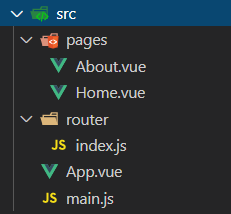1. 理解
1.1. 说明
- 官方提供的用来实现SPA 的vue 插件
- github: https://github.com/vuejs/vue-router
- 中文文档: http://router.vuejs.org/zh-cn/
- 下载:
npm install vue-router --save
1.2. 相关API 说明
- VueRouter(): 用于创建路由器的构建函数
new VueRouter({
// 多个配置项
})
- 路由配置
routes: [
{
// 一般路由
path: '/about',
component: About
},
{
// 自动跳转路由
path: '/',
redirect: '/about'
}
]
- 注册路由器
import router from './router'
new Vue({
router
})
- 使用路由组件标签
<router-link>: 用来生成路由链接
<router-link to="/xxx">Go to XXX</router-link>
<router-view>: 用来显示当前路由组件界面
<router-view></router-view>
2. 基本路由
2.1. 效果

2.2. 路由组件

Home.vue
About.vue
2.3. 应用组件: App.vue
<template>
<div>
<div class="row">
<div class="col-xs-offset-2 col-xs-8">
<div class="page-header"><h2>Router Test</h2></div>
</div>
</div>
<div class="row">
<div class="col-xs-2 col-xs-offset-2">
<div class="list-group">
<!--生成路由链接-->
<router-link to="/about" class="list-group-item">About</router-link>
<router-link to="/home" class="list-group-item">Home</router-link>
</div>
</div>
<div class="col-xs-6">
<div class="panel">
<div class="panel-body">
<!--显示当前组件-->
<keep-alive>
<router-view msg="abc"></router-view>
</keep-alive>
</div>
</div>
</div>
</div>
</div>
</template>
2.4. 路由器模块: src/router/index.js
import Vue from 'vue'
import Router from 'vue-router'
import About from '../pages/About'
import Home from '../pages/Home'
Vue.use(Router)
export default new Router({
routes: [
{
path: '/about',
component: About
},
{
path: '/home',
component: Home
},
{
path: '/',
component: About
}
]
})
2.5. 注册路由器: main.js
import Vue from 'vue'
import App from './App'
import router from './router'
Vue.config.productionTip = false
/* eslint-disable no-new */
new Vue({
// 配置对象的属性名都是一些确定的名称,不能随便修改
el: '#app',
router,
components: {
App },
template: '<App/>'
})
2.6. 优化路由器配置
linkActiveClass: 'active', // 指定选中的路由链接的class
2.7. 总结: 编写使用路由的3 步
- 定义路由组件
- 注册路由
- 使用路由
<router-link>
<router-view>
3. 嵌套路由
3.1. 效果

3.2. 子路由组件

News.vue
<template>
<ul>
<li v-for="(news, index) in newsArr" :key="index">{
{ news }}</li>
</ul>
</template>
<script>
export default {
data() {
return {
newsArr: ["news001", "news002", "news003", "news004"],
};
},
};
</script>
<style>
</style>
Message.vue
<template>
<ul>
<li v-for="message in messages" :key="message.id">
<a href="#">{
{ message.title }}</a>
</li>
</ul>
</template>
<script>
export default {
data() {
return {
messages: [],
};
},
mounted() {
//模拟ajax请求从后台获取数据
setTimeout(() => {
const messages = [
{
id: 1,
title: "message001",
},
{
id: 2,
title: "message002",
},
{
id: 3,
title: "message003",
},
];
this.messages = messages;
}, 1000);
},
};
</script>
<style>
</style>
3.3. 配置嵌套路由: src/router/index.js
import Vue from 'vue'
import Router from 'vue-router'
import About from '../pages/About'
import Home from '../pages/Home'
import News from '../pages/News'
import Message from '../pages/Message'
Vue.use(Router)
export default new Router({
routes: [
{
path: '/about',
component: About
},
{
path: '/home',
component: Home,
children: [
{
// path: '/news' // path最左侧斜杠代表根路径
path: '/home/news', //完整写法
component: News
},
{
path: 'message', // 简化写法
component: Message
},
{
//设置默认显示
path: '',
redirect: '/home/news'
}
]
},
{
//设置默认显示
path: '/',
redirect: '/about'
}
]
})
3.4. 路由链接: Home.vue
<template>
<div>
<h2>Home</h2>
<div>
<ul class="nav nav-tabs">
<li>
<router-link to="/home/news">News</router-link>
<router-link to="/home/message">Message</router-link>
</li>
</ul>
<div>
<router-view></router-view>
<hr />
</div>
</div>
</div>
</template>
<script>
export default {
};
</script>
<style>
</style>
4. 向路由组件传递数据
4.1. 效果
4.2. 方式1: 路由路径携带参数(param/query)
- 配置路由
children: [
{
path: 'mdetail/:id',
component: MessageDetail
}
]
- 路由路径
<router-link :to="'/home/message/mdetail/'+m.id">{
{m.title}}</router-link>
- 路由组件中读取请求参数
this.$route.params.id
4.3. 方式2: <router-view>属性携带数据
<router-view :msg="msg"></router-view>
然后组件用props接收
示例
MessageDetail.vue
<template>
<ul>
<li>id: {
{ messageDetail.id }}</li>
<li>title: {
{ messageDetail.title }}</li>
<li>content: {
{ messageDetail.content }}</li>
</ul>
</template>
<script>
export default {
data() {
return {
messageDetail: {
id: "",
title: "",
content: "",
},
};
},
mounted() {
setTimeout(() => {
const allMessageDetails = [
{
id: 1,
title: "message001",
content: "message001 content...",
},
{
id: 2,
title: "message002",
content: "message002 content...",
},
{
id: 3,
title: "message003",
content: "message003 content...",
},
];
this.allMessageDetails = allMessageDetails;
const id = this.$route.params.id * 1;
this.messageDetail = allMessageDetails.find((detail) => detail.id === id);
}, 1000);
},
watch: {
$route: function(value){
// 路由路径(param)发生了改变
const id = value.params.id * 1;
this.messageDetail = this.allMessageDetails.find((detail) => detail.id === id);
}
}
};
</script>
<style>
</style>
index.js
import Vue from 'vue'
import Router from 'vue-router'
import About from '../pages/About'
import Home from '../pages/Home'
import News from '../pages/News'
import Message from '../pages/Message'
import MessageDetail from '../pages/MessageDetail'
Vue.use(Router)
export default new Router({
routes: [
{
path: '/about',
component: About
},
{
path: '/home',
component: Home,
children: [
{
// path: '/news' // path最左侧斜杠代表根路径
path: '/home/news', //完整写法
component: News
},
{
path: 'message', // 简化写法
component: Message,
children: [
{
path: '/home/message/detail/:id',
component: MessageDetail
}
]
},
{
//设置默认显示
path: '',
redirect: '/home/news'
}
]
},
{
//设置默认显示
path: '/',
redirect: '/about'
}
]
})
5. 缓存路由组件对象
5.1. 理解
- 默认情况下, 被切换的路由组件对象会死亡释放, 再次回来时是重新创建的
- 如果可以缓存路由组件对象, 可以提高用户体验
5.2. 编码实现
<keep-alive>
<router-view></router-view>
</keep-alive>
6. 编程式路由导航
6.1. 效果

6.2. 相关API
this.$router.push(path): 相当于点击路由链接(可以返回到当前路由界面)this.$router.replace(path): 用新路由替换当前路由(不可以返回到当前路由界面)this.$router.back(): 请求(返回)上一个记录路由this.$router.go(-1): 请求(返回)上一个记录路由this.$router.go(1): 请求下一个记录路由
示例
Message.vue
<template>
<div>
<ul>
<li v-for="message in messages" :key="message.id">
<!-- <a href="#">{
{ message.title }}</a> -->
<router-link :to="`/home/message/detail/${message.id}`">{
{
message.title
}}</router-link>
<button @click="pushShow(message.id)">push查看</button>
<button @click="replaceShow(message.id)">replace查看</button>
</li>
</ul>
<button @click="$router.back()">回退</button>
<hr />
<router-view></router-view>
</div>
</template>
<script>
export default {
data() {
return {
messages: [],
};
},
methods: {
pushShow(id) {
this.$router.push(`/home/message/detail/${
id}`);
},
replaceShow(id) {
this.$router.replace(`/home/message/detail/${
id}`);
},
},
mounted() {
//模拟ajax请求从后台获取数据
setTimeout(() => {
const messages = [
{
id: 1,
title: "message001",
},
{
id: 2,
title: "message002",
},
{
id: 3,
title: "message003",
},
];
this.messages = messages;
}, 1000);
},
};
</script>
<style>
</style>